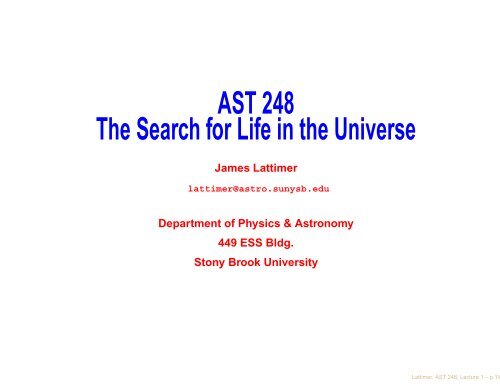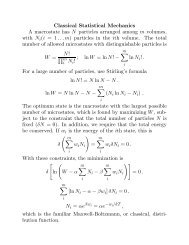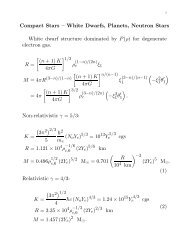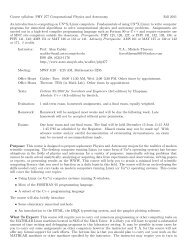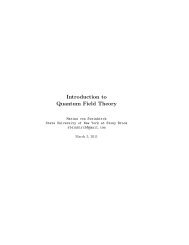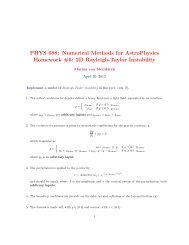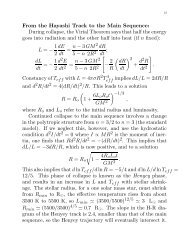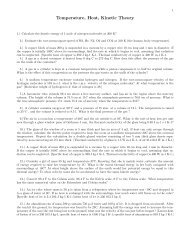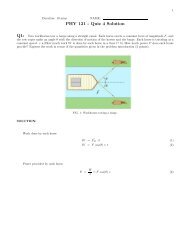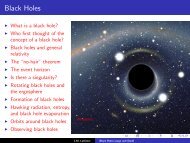AST 248 The Search for Life in the Universe - Stony Brook Astronomy
AST 248 The Search for Life in the Universe - Stony Brook Astronomy
AST 248 The Search for Life in the Universe - Stony Brook Astronomy
Create successful ePaper yourself
Turn your PDF publications into a flip-book with our unique Google optimized e-Paper software.
<strong>AST</strong> <strong>248</strong><br />
<strong>The</strong> <strong>Search</strong> <strong>for</strong> <strong>Life</strong> <strong>in</strong> <strong>the</strong> <strong>Universe</strong><br />
James Lattimer<br />
lattimer@astro.sunysb.edu<br />
Department of Physics & <strong>Astronomy</strong><br />
449 ESS Bldg.<br />
<strong>Stony</strong> <strong>Brook</strong> University<br />
Lattimer, <strong>AST</strong> <strong>248</strong>, Lecture 1 – p.1/8
Course Components<br />
• Office Hours: 2:30 – 3:30 M, Tu, W, Th, ESS 449<br />
• Course URL http://www.astro.sunysb.edu/lattimer/<strong>AST</strong><strong>248</strong><br />
• Required text: "<strong>Life</strong> <strong>in</strong> <strong>the</strong> <strong>Universe</strong>" by Bennett, Shostak and Jakosky.<br />
• Various supplemental, non-required, texts: assists with homeworks and term<br />
papers<br />
• Exams: Three major exams, each count<strong>in</strong>g 20%:<br />
27 February, 10 April, 22 May (9:00 AM)<br />
• Homeworks: Count 20%, 1 per week (except exams). Will drop lowest grade. Late<br />
penalty applies.<br />
• Term Report: Counts 20%. Due March 13. Late penalty applies. Must select<br />
specific topic relevant to course, not too general (see syllabus <strong>for</strong> suggestions and<br />
more specific <strong>in</strong>structions). Extra credit term report due April 24 <strong>for</strong> full credit. Must<br />
select a different topic.<br />
• Prerequisite: One category DEC E course. This course assumes and uses<br />
algebra, trigonometry, scientific notation, logarithms, exponentials, powers, etc.<br />
• Be <strong>for</strong>ewarned about <strong>the</strong> consequences of plagiarism<br />
Lattimer, <strong>AST</strong> <strong>248</strong>, Lecture 1 – p.2/8
Overview of <strong>Search</strong> <strong>for</strong> Intelligent <strong>Life</strong><br />
1. Historical Introduction<br />
2. Astronomical Sett<strong>in</strong>g:<br />
Distances, Masses and Energies<br />
3. Light, Stars and Planets<br />
4. <strong>The</strong> <strong>Universe</strong>, Cosmology and <strong>the</strong> Anthropic Pr<strong>in</strong>ciple<br />
5. Geology and <strong>the</strong> Earth<br />
6. <strong>Life</strong>:<br />
its Nature, Orig<strong>in</strong>, Evolution, Metabolism, and Heredity<br />
7. Extreme and O<strong>the</strong>r Forms of <strong>Life</strong><br />
8. <strong>Search</strong><strong>in</strong>g <strong>for</strong> <strong>Life</strong> <strong>in</strong> <strong>the</strong> Solar System:<br />
<strong>the</strong> Moon, Venus, Mars, <strong>the</strong> Jovian Satellites, and Titan<br />
9. <strong>Search</strong><strong>in</strong>g <strong>for</strong> <strong>Life</strong> <strong>in</strong> <strong>the</strong> Galaxy:<br />
Exoplanets and Habitable Zones<br />
10. SETI and Consequences of Contact<br />
11. Space Travel, <strong>the</strong> Fermi Paradox, and UFOs<br />
Lattimer, <strong>AST</strong> <strong>248</strong>, Lecture 1 – p.3/8
Ancient Th<strong>in</strong>k<strong>in</strong>g<br />
Belief <strong>in</strong> ETI was widespread <strong>in</strong> ancient Mediterranean world –<br />
Pythagoras (570–500 BC), Democritus (460–370 BC), Epicurus (341-270 BC).<br />
Atomist <strong>the</strong>ory.<br />
In contrast, Aristotle (384–322 BC) denied multiple worlds existed, to impose order on<br />
universe.<br />
Two ancient schools of thought about life <strong>in</strong> <strong>the</strong> universe (but <strong>the</strong>se persist today):<br />
1. Plutarch: premise of design—<strong>The</strong> Face that is <strong>in</strong> <strong>the</strong> Orb of <strong>the</strong> Moon<br />
• <strong>The</strong> Earth is not privileged<br />
• Heavenly bodies are not “naturally” positioned; hence <strong>the</strong>re is <strong>in</strong>telligent<br />
design<br />
• Moon is sufficiently like Earth to support life<br />
• If Moon lifeless, it would exist to no purpose – <strong>in</strong>consistent with <strong>in</strong>telligent<br />
design<br />
2. Lucretius: premise of plurality<br />
• Accepts 1 & 3 above.<br />
• Believes <strong>in</strong> Atomist <strong>the</strong>ory.<br />
• No design, but <strong>in</strong>numerable worlds imply a plurality of <strong>in</strong>telligences.<br />
Lattimer, <strong>AST</strong> <strong>248</strong>, Lecture 1 – p.4/8
Less Ancient Th<strong>in</strong>k<strong>in</strong>g<br />
1. Western thought through middle ages dom<strong>in</strong>ated by Aristotle’s rigid philosophy.<br />
• St. August<strong>in</strong>e believed <strong>in</strong> <strong>the</strong> <strong>the</strong>ological uniqueness of life on Earth.<br />
• St. Thomas Aqu<strong>in</strong>as wrote that God could have created many, but chose to<br />
create only one, <strong>in</strong>habited planet.<br />
• Until Copernicus, <strong>the</strong> Church refused to accept <strong>the</strong>se ideas.<br />
• After Copernicus, <strong>the</strong>ology was Plutarch-like.<br />
• After Darw<strong>in</strong>, Lucretian-like philosophy accepted.<br />
2. Criticism <strong>in</strong> 19th century:<br />
• Whewell (1854): Astronomical, geological evidence that number of planetary<br />
systems was small; “imperfect design if unredeemable souls existed on o<strong>the</strong>r<br />
planets”.—<strong>The</strong> Plurality of Worlds<br />
• Refutation of <strong>the</strong>ory of spontaneous generation (Redi, Pasteur)<br />
• Objections to Kant-Laplace nebular hypo<strong>the</strong>sis of solar system orig<strong>in</strong> raised<br />
by Jeans, who favored <strong>the</strong> catastrophic tidal <strong>the</strong>ory of Chamberl<strong>in</strong>: a stellar<br />
close encounter.<br />
3. Objections overturned <strong>in</strong> 20th century:<br />
• Miller-Urey experiment<br />
• Astronomical observations favored non-unique nature of <strong>the</strong> Earth, solar<br />
system, and <strong>the</strong> Galaxy.<br />
Lattimer, <strong>AST</strong> <strong>248</strong>, Lecture 1 – p.5/8
Modern Thought – 20th Century<br />
1. Astronomical observations and Miller-Urey experiment re<strong>in</strong><strong>for</strong>ced plurality<br />
• SETI begun (Cocconi and Morrison 1960), Project Ozma (Drake 1960)<br />
2. Not so fast!<br />
• Exploration of solar system reveals planets to be un<strong>in</strong>habitable and deadly<br />
• SETI revolt (Hart, Tipler 1975)<br />
• <strong>The</strong> Fermi Paradox<br />
• Evolutionary biologists <strong>in</strong>fer <strong>the</strong> highly random nature of evolution and debate<br />
evolutionary convergence and gradualism vs. catastrophism<br />
• Realization of astronomical <strong>in</strong>fluences on orig<strong>in</strong> of and evolution of life<br />
(catastrophic impacts, supernovae, gamma ray bursts)<br />
3. But o<strong>the</strong>r worlds and o<strong>the</strong>r life may be more common than we thought:<br />
• IRAS detects dust debris around young star Vega: proto-planetary disc (1983)<br />
• 1st brown dwarf (van Biesbrock 8) discovered, speckle <strong>in</strong>terferometry (1988)<br />
• Advances <strong>in</strong> astrometry lead to first discoveries of extra-solar planets (1995)<br />
by Mayor and Queloz. Rapidly followed by many more, many by Marcy and<br />
Butler: 778 to date.<br />
• Exploration of Earth reveals tenacity of life (hydro<strong>the</strong>rmal vents 1977,<br />
extremophiles 70’s and 80’s, deep subsurface bacteria 80’s and 90’s,<br />
nanobacteria 1996)<br />
• Martian meteorite may provide evidence of extraterrestrial life (1996)<br />
Lattimer, <strong>AST</strong> <strong>248</strong>, Lecture 1 – p.6/8
Some Quotes and Comments<br />
400 BC Metrodorus of Chios (Greece) “It is unnatural <strong>in</strong> a large field to have only one<br />
shaft of wheat and <strong>in</strong> <strong>the</strong> <strong>in</strong>f<strong>in</strong>ite <strong>Universe</strong> only one liv<strong>in</strong>g world.”—On Nature<br />
50 BC Lucretius (Rome) “Noth<strong>in</strong>g <strong>in</strong> <strong>the</strong> <strong>Universe</strong> is unique and alone, and <strong>the</strong>re<strong>for</strong>e <strong>in</strong><br />
o<strong>the</strong>r regions <strong>the</strong>re must be o<strong>the</strong>r earths <strong>in</strong>habited by different tribes of men and<br />
breeds of beasts.”—De Rerum Natura<br />
1600 Giordano Bruno (Italy) “. . . an <strong>in</strong>f<strong>in</strong>ite number of suns with planets with life around<br />
<strong>the</strong>m.” He espoused <strong>the</strong> heliocentric <strong>the</strong>ory of Copernicus, <strong>for</strong> which he was<br />
burned at <strong>the</strong> stake.<br />
1690 Christiaan Huygens (Ne<strong>the</strong>rlands) “. . . barren planets, deprived of liv<strong>in</strong>g creatures<br />
which speak most highly of <strong>the</strong>ir Div<strong>in</strong>e Architect are unreasonable, wasteful and<br />
uncharacteristic of God, who has a purpose <strong>for</strong> everyth<strong>in</strong>g.” —Cosmo <strong>the</strong>reos A<br />
consumate politician!<br />
1830 Carl Gauss (Germany) proposed build<strong>in</strong>g a colossal <strong>for</strong>est <strong>in</strong> <strong>the</strong> shape of a right<br />
triangle <strong>in</strong> Siberia <strong>in</strong> order to signal extraterrestrial civilizations of our existence.<br />
1835 Richard Locke (USA) wrote a series of fake articles <strong>for</strong> <strong>the</strong> New York Sun that said<br />
British astronomer John Herschell had observed ape-like <strong>in</strong>habitants on <strong>the</strong> Moon.<br />
About half of New York City believed him, and a large number of people cont<strong>in</strong>ued<br />
to accept <strong>the</strong> hoax even after he confessed to writ<strong>in</strong>g phony stories.<br />
Lattimer, <strong>AST</strong> <strong>248</strong>, Lecture 1 – p.7/8
1877 Schiaparelli (Italy) reported see<strong>in</strong>g canali on Mars. Although <strong>in</strong> Italian this means<br />
channels, it was <strong>in</strong>correctly translated as canals <strong>in</strong> <strong>the</strong> popular press.<br />
1880’s Percival Lowell (USA) took <strong>the</strong> press’ mistranslation of canali and conv<strong>in</strong>ced<br />
himself of <strong>the</strong> existence of <strong>in</strong>telligent life on Mars.<br />
1892 Flammarion (France) wrote that <strong>in</strong> <strong>the</strong> distant future, after <strong>the</strong> <strong>in</strong>vention of<br />
completely new technology, civilizations might communicate across space. He<br />
didn’t know that radio had just been <strong>in</strong>vented!<br />
1901 Tesla (USA) detected strange, rythmic, signals on his antenna at Colorado<br />
Spr<strong>in</strong>gs. It has never been determ<strong>in</strong>ed exactly what he found.<br />
1902 Lord Kelv<strong>in</strong> (England) proposed that Tesla was observ<strong>in</strong>g radio signals from Mars<br />
to New York, <strong>the</strong> “most marvelously lighted city <strong>in</strong> <strong>the</strong> world” and <strong>the</strong> only city that<br />
could be visible to Martians.<br />
1920’s Marconi (Italy), after also record<strong>in</strong>g strange signals, sent <strong>the</strong> first radio signals<br />
<strong>in</strong>to space, <strong>in</strong> <strong>the</strong> direction of Mars, to contact extraterrestrial life <strong>the</strong>re. <strong>The</strong> signals<br />
were sent from Nova Scotia.<br />
1938 Orson Welles (USA) Martian hysteria reached a peak when he broadcast a version<br />
of <strong>the</strong> classic sci-fi novel of H.G. Wells, “War of <strong>the</strong> Worlds”, to a New Jersey/New<br />
York audience. Thousands of people panicked upon hear<strong>in</strong>g of <strong>the</strong> alien <strong>in</strong>vasion.<br />
Lattimer, <strong>AST</strong> <strong>248</strong>, Lecture 1 – p.8/8


